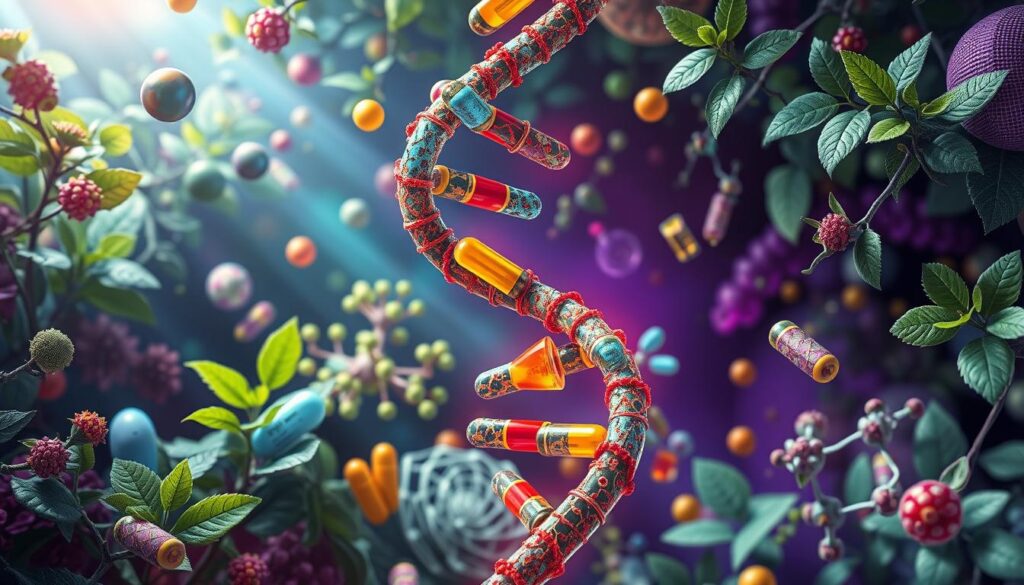The world of health and wellness is changing fast. Now, we have personalized vitamins instead of one-size-fits-all supplements. Our unique genetic makeup, lifestyle, and health goals are now the focus, changing how we get our daily nutrients.
Personalized vitamins are a big step forward in health. They use advanced science and tech to make supplements just for us. We’re no longer stuck with generic multivitamins that might not meet our specific needs or health goals.
We’ll look into the big change happening in the supplement world. We’ll see how it moves from generic to personalized nutrition. We’ll learn about the science behind it, its benefits, and how to get the most out of custom supplements for our health.
Understanding the Revolution in Custom Supplements
The supplement industry is changing fast, moving from a one-size-fits-all model to personalized solutions. This change comes from our growing knowledge of our unique nutritional needs. Traditional supplements, though easy to use, don’t meet the specific health needs of each person.
The Shift from One-Size-Fits-All to Personalized Solutions
Nutrigenomics, the study of how our genes and nutrients interact, is leading this change. It helps us find out which nutrients we’re missing and why. This lets us create individualized nutritional needs and supplements that match our unique health goals.
Why Traditional Supplements Fall Short
Traditional supplements give a wide range of vitamins and minerals but don’t meet everyone’s needs. They might have things we don’t need or not enough of what we do need. Personalized supplements ensure we get the exact bespoke micronutrients our bodies need for health.
| Traditional Supplements | Personalized Supplements |
|---|---|
| Standardized formulas | Tailored to individual needs |
| May contain unnecessary ingredients | Targeted to specific deficiencies and health concerns |
| Lack optimal dosages for individual needs | Optimized for maximum absorption and effectiveness |
This shift in custom supplements lets us take charge of our health. By choosing personalized options, we can maximize the benefits of supplements. This opens up a new chapter in achieving our best health.
How DNA-Based Nutrition is Changing the Supplement Game
In the world of health and wellness, a big change is happening. dna-based nutrition and genetic-based supplementation are changing how we take vitamins. Now, we can make supplements that fit our unique needs based on our genes.
It starts with a DNA test. This test gives us insights into our genetic makeup. With this info, we can find out what nutrients we lack and how our body works. Then, we can make a supplement just for us.
We no longer need the same vitamins for everyone. dna-based nutrition means we can get vitamins that really fit us. This way, our bodies get exactly what they need to stay healthy.
| Nutrient | Traditional Supplement | DNA-Based Supplement |
|---|---|---|
| Vitamin D | Standard 1,000 IU | Personalized based on genetic markers |
| Omega-3 Fatty Acids | Fixed EPA/DHA ratio | Adjusted ratio based on individual needs |
| B-Vitamins | Uniform dosage | Customized based on genetic variations |
This new way of taking supplements meets our unique needs. It also makes nutrients work better in our bodies. By matching our supplements to our genes, we get the most out of them. This leads to better health and wellness.

“Personalized vitamins are the future of health and wellness. By harnessing the power of our genetic information, we can create supplement regimens that truly cater to our individual needs.” – Dr. Emily Watkins, Nutritional Genomics Researcher
The world of dna-based nutrition is growing fast. We’re at the start of a big change in supplements. By using this personalized method, we can reach our health goals and live our best lives.
The Science Behind Personalized Vitamins
Unlocking the power of personalized vitamins starts with nutrigenomics. This field explores how our genes affect our nutrient needs. It shows how our bodies react to different micronutrients.
Understanding Nutrigenomics
Nutrigenomics studies how genes and genetic variations affect our nutrition. By looking at our DNA, we learn what nutrients our body needs. This helps us tailor our supplements for better health.
Genetic Markers and Nutrient Needs
Our genes tell our body how to use nutrients. Genetic markers like SNPs show how well we process vitamins and minerals. Knowing this helps create the best personalized nutrient plans for health.
Bioavailability and Individual Absorption
Bioavailability is how well our body uses nutrients. It can change based on many factors like gut health and age. Personalized vitamins can be made to fit each person’s unique needs for better nutrient absorption.
| Nutrient | Genetic Marker | Impact on Nutrient Needs |
|---|---|---|
| Vitamin D | VDR, CYP2R1, GC | Influences the body’s ability to synthesize and metabolize vitamin D |
| Folate | MTHFR | Affects the conversion of folate to its active form, methylfolate |
| Omega-3 Fatty Acids | FADS1, FADS2 | Regulates the conversion of ALA to EPA and DHA |

“By understanding the science of nutrigenomics, we can unlock the true potential of personalized vitamins and ensure that our bodies receive the precise micronutrients they need to thrive.”
Benefits of Tailored Micronutrition for Your Health
Personalized vitamins can bring many health benefits. They are not like one-size-fits-all supplements. Tailored micronutrition uses nutrigenomics to give your body the exact nutrients it needs.
Understanding your genetic makeup and metabolic profile helps us create a custom vitamin plan. This plan boosts nutrient absorption and targets health issues. It ensures your body gets the right mix of vitamins, minerals, and antioxidants for your wellbeing.
Improved Nutrient Absorption
Personalized vitamins are made to be easily absorbed by your body. This means your body can use the nutrients better. It leads to better support for your body’s systems.
Targeted Health Support
Tailored micronutrition helps with specific health needs. It supports heart health, brain function, and bone density. Personalized vitamins let you actively manage your health.
Optimized Bodily Functions
Personalized vitamins regulate body processes like energy and immune function. They give your body the right nutrients. This improves your overall health and energy levels.
| Benefit | Description |
|---|---|
| Improved Nutrient Absorption | Personalized vitamins are designed to be highly bioavailable, ensuring your body can efficiently utilize the nutrients. |
| Targeted Health Support | Tailored micronutrition allows you to address specific health concerns, such as cardiovascular health or cognitive function. |
| Optimized Bodily Functions | Personalized vitamins can help regulate various bodily processes, promoting overall wellness and vitality. |
“Personalized vitamins have been a game-changer for my health. The targeted support has helped me feel more energized and focused than ever before.”

Getting Started with Personalized Vitamins
Personalized vitamins are changing how we think about health and wellness. They let us tailor our supplements to fit our unique genetic makeup. This way, we can make the most of custom supplements for better overall health. But how do we start this personalized journey? Let’s explore the process together.
Assessment Process
The first step is a detailed assessment. We fill out a questionnaire about our health, lifestyle, and diet. We might also give a blood sample or DNA test to learn more about our nutrient needs.
Consultation and Testing Options
After the assessment, we meet with a nutrition expert. They’ll look at our data and suggest the best next steps. We might choose to do more tests, like nutrient panels or genetic analysis, to understand our body better.
Creating Your Custom Formula
With the insights from our assessment and consultation, our healthcare provider creates a custom supplement for us. This blend of vitamins, minerals, and other nutrients is made just for us. It’s designed to meet our specific health needs.
Starting on the path of personalized vitamins is a powerful step towards better health. By understanding our unique needs and working with experts, we can unlock the full potential of custom supplements. This leads to the benefits of tailored micronutrient profiles.

Common Ingredients in Custom Supplement Formulas
Custom supplements vary based on your nutritional needs. They include common ingredients that are chosen for you. These vitamins and minerals are picked to meet your health goals and genetic makeup.
Essential vitamins like A, C, D, E, and B-complex are key. They support your overall health. Your specific needs and lifestyle guide their dosages.
Minerals like zinc, iron, calcium, and magnesium are also important. They help with bone health and immune function. The amounts are adjusted for your body’s best use.
Other ingredients like omega-3s, antioxidants, and probiotics may be included. They’re chosen to fit your health goals. This could be for heart health, brain function, or gut health.
| Ingredient | Function | Customized Dosage |
|---|---|---|
| Vitamin D | Supports bone health, immune function, and mood | Adjusted based on individual blood levels and sun exposure |
| Zinc | Promotes immune system health and wound healing | Tailored to individual needs, such as for vegetarians or those with digestive issues |
| Omega-3s | Supports heart health, brain function, and inflammation reduction | Customized based on personal health goals and dietary intake |
Understanding custom supplement ingredients helps you see how they’re tailored for you. This personalized approach ensures you get the right support for your body.

Making the Most of Your Bespoke Micronutrients
Getting the most out of personalized vitamins is key. Knowing the best time and amount to take them is important. This way, you can fully enjoy the benefits of your tailored nutrition.
Optimal Timing and Dosage
The timing and amount of your vitamins matter a lot. Our bodies need different things at different times. Talking to your doctor or vitamin provider can help figure out the best time for you.
Some vitamins are better taken on an empty stomach, while others need food. It’s also important to follow the recommended amounts. Too little or too much can affect how well they work.
Lifestyle Integration Tips
- Establish a routine: Make taking your vitamins a daily habit by doing it at the same time every day.
- Pair with meals: If your vitamins are best with food, take them during meals.
- Set reminders: Use digital alarms, calendar notifications, or sticky notes to remember to take your vitamins.
- Carry on-the-go: Keep a small supply of your vitamins in your bag or office, so you can take them anytime.
- Communicate with your healthcare provider: Keep your doctor updated on your vitamin routine, so they can help adjust as needed.
By following these tips and working with your vitamin provider, you can easily add these nutrients to your daily routine. This ensures you get the most out of this new way of supplementing.

Cost Considerations and Insurance Coverage
Thinking about the cost of personalized vitamins and custom supplements is natural. But, see it as a long-term investment in your health. Personalized vitamins might cost more upfront than generic ones. But, they offer tailored benefits that can be more valuable over time.
The price of personalized vitamins depends on several factors. These include the testing scope, your nutrient needs, and the supplement’s formulation. On average, a custom supplement plan can cost between $50 and $150 monthly. This might seem more than regular supplements. Yet, consider the long-term health benefits and savings it can bring.
Exploring Insurance Coverage
Some insurance plans now cover personalized vitamins and custom supplements. This is because they see the long-term value in these tailored options. Check your insurance and talk to your healthcare provider to see if you can get some or all of it covered.
By making personalized vitamins more affordable, we help people take charge of their health. This investment can lead to better energy, a stronger immune system, and lower risks of chronic diseases.
“Investing in personalized vitamins is an investment in your long-term health and wellness. It’s a proactive step towards optimizing your body’s unique nutrient needs.”
Conclusion
The world of personalized vitamins is changing how we think about nutrition. Thanks to advanced nutrigenomics, we can now get supplements made just for us. These are based on our genes and how we live.
Personalized vitamins are much better than generic ones. They fill our specific nutrient gaps and work better in our bodies. This means better health, more energy, and sharper minds.
Exploring personalized vitamins is key to improving our health. We invite you to see how these tailored solutions can boost your wellness. Start your journey to better health with a supplement made just for you.





2 Comments